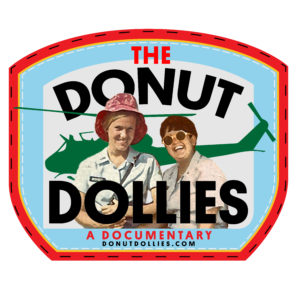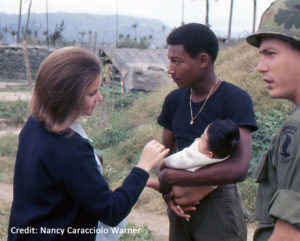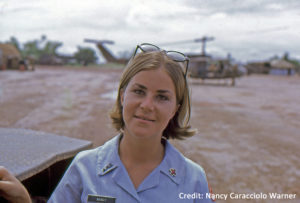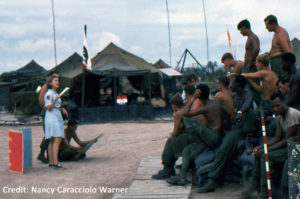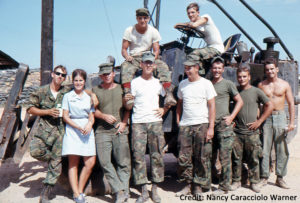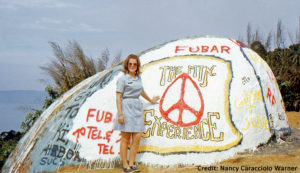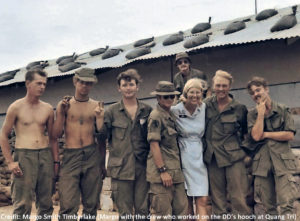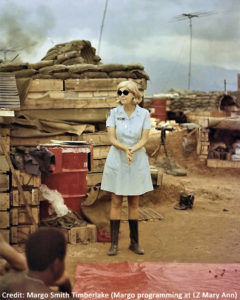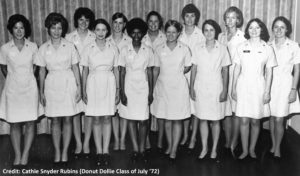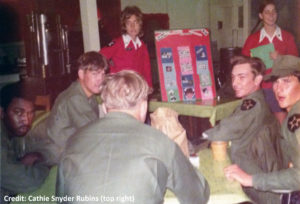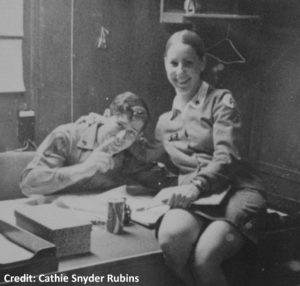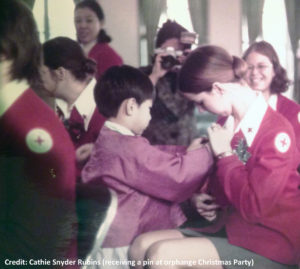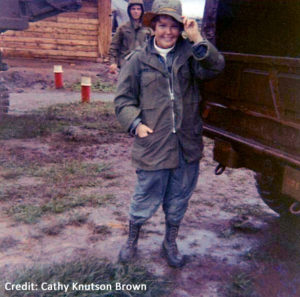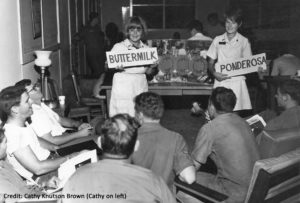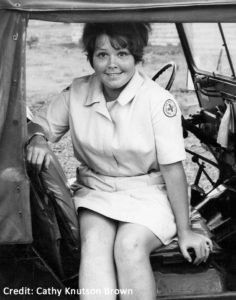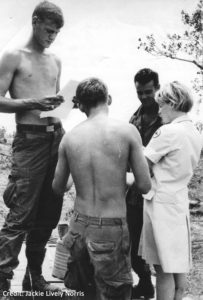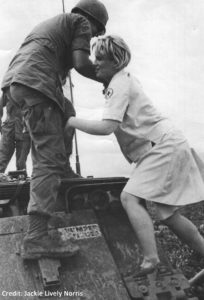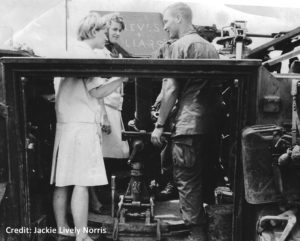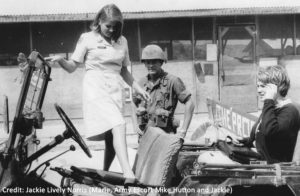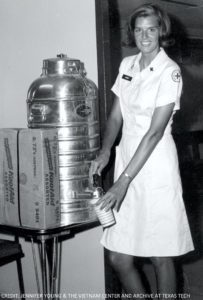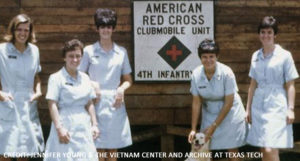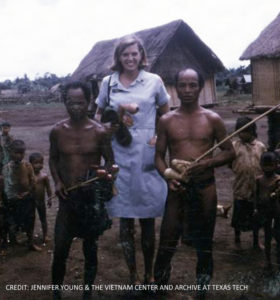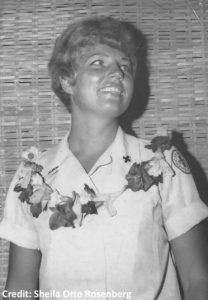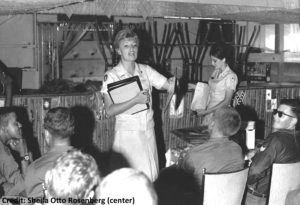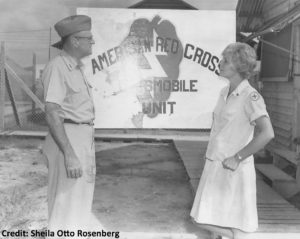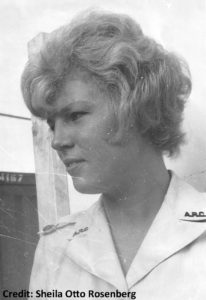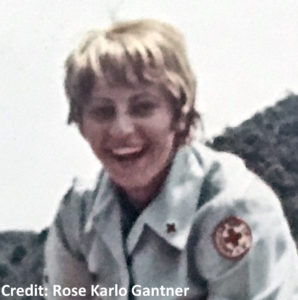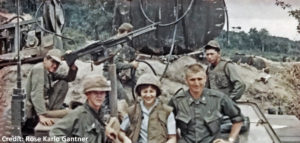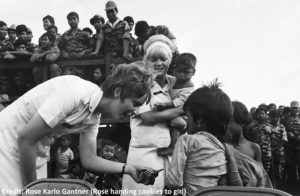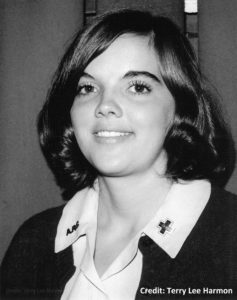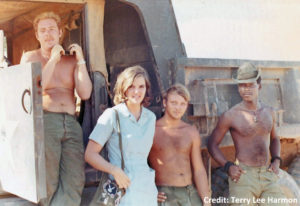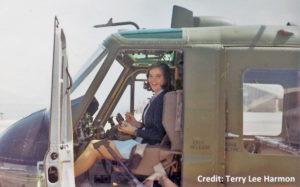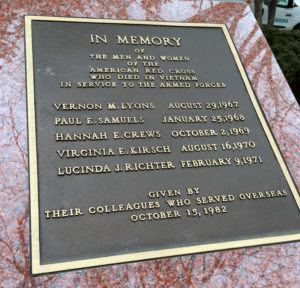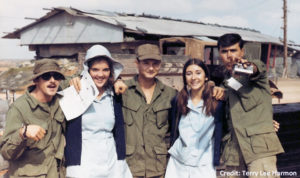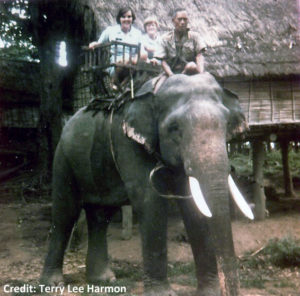In our thirty second edition of the Donut Dollie Detail, Sherry tells how growing up in a military family informed her decision to go to Vietnam to support our soldiers, how she had a couple close calls, including a mortar landing in the middle of a stand down party she was attending, and how the Donut Dollies were at the forefront of the women’s movement and that she believes they made a difference for the men who served.
Please share the Donut Dollie Detail with family, friends and veterans you may know, and make sure to like/follow us on Facebook to learn when the next edition is posted.
Please meet Red Cross Donut Dollie Sherry Giles Cozzalio Taylor…
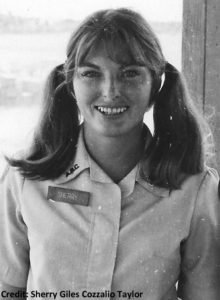 What prompted you to join the SRAO (Supplemental Recreation Activities Overseas) program and want to go to Vietnam?
What prompted you to join the SRAO (Supplemental Recreation Activities Overseas) program and want to go to Vietnam?
I grew up in a military family. I understood the sacrifice a man makes when he chooses to serve and safeguard his country. Many of the boys I went to high school with were drafted and went to fight a war we didn’t understand and were too young to know what we supported. In 1968, I was a senior attending Oklahoma State University. Three months before graduation, I had a teaching job lined up and was planning a move to Evergreen, Colorado the following August. During the late 60’s there were few opportunities for women to serve their country, so when, I read an article about college graduates working for the Red Cross in Vietnam, I knew I had found a rare opportunity to serve my country. During a time of anti-war protests, I was going to show our young soldiers I cared about them and supported them.
I applied to the American Red Cross for a position with Supplemental Recreational Activities Overseas. I received a letter back with an airline ticket to St. Louis, MO., to interview for the position. During the interview I was told only people who volunteer for Vietnam were sent there. I volunteered. A few weeks before graduation I received word I had been hired and was scheduled to attend the June class in Charlottesville, VA. In training, I learned to hem my blue dress no shorter than knee length and to style my hair so it didn’t touch my collar. We studied the history of the Red Cross, military rank and protocol, and learned how to develop a program. Six weeks after my college graduation, I stepped off a plane at Tan Son Nhut Air Base to a blast of heat and unusual smells. I never made it to Colorado and have never regretted it.
When and where were you stationed in Vietnam? Did you go by a nickname?
I was first stationed at Long Binh (II Field Force) from June – October, 1968, then TDY (temporary duty) at Phan Rang Air Base in October, 1968, followed by Bien Hoa from November, 1968 – January, 1969 and finally Dong Tam from January – June, 1969. I was known as Sherry in Vietnam.
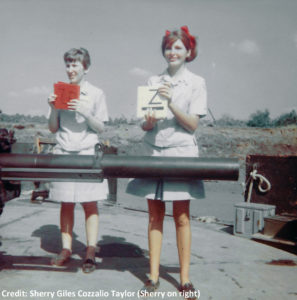 What was a routine day like in Vietnam?
What was a routine day like in Vietnam?
Each unit was different. Long Binh had 12 girls while Bien Hoa had five. We would go out in pairs. We were usually scheduled with a different Donut Dollie each day. A new girl was always scheduled with a seasoned girl, who taught her what to do and introduced her to the guys in the units.
The Long Binh (II Field Force) Unit had a Recreation Center. We usually had one day each week scheduled in the Recreation Center. We also used this time to develop our programs and perform our assigned unit duties (mine was secretary – I typed the notes taken during our weekly staff meetings). In pairs, we also traveled by jeep to many Long Binh units such as, logistics support, motor pools, signal units, etc. We went by jeep to Saigon to visit combat troops positioned in Cho Lon and at the Y-bridge; traveled by jeep to an Australian unit at Nui Dat; flew by helicopter to a signal unit on Hill 831, Nui Ba Din and flew to Ka Tum. We also supported Bien Hoa Air Base. When we were on the road visiting combat troops, we were up early to program at several different units. We ate C-rations for lunch that the troops shared with us, while sitting on sandbags or under whatever shade we could find. We arrived home in time for a meal in the II Field Force Officer’s mess. Our home had a 12’ fence surrounding our long two-story barracks. We showered in an open bay with six showerheads – no hot water. Our rooms were small, with a cot and screened opening for air circulation.
The Phan Rang Air Base unit was a treat. The Air Force had given this unit of Donut Dollies their own pink jeep and provided them with a well furnished air-conditioned “home” with hot water. Each bedroom had a nice twin size bed and mattress. I worked in the Recreation Center the two weeks I was there.
The Bien Hoa Army Unit opened in October. We lived in a Quonset hut next to the fire station. It was hot so we rarely closed the openings that served as windows in our rooms. Our rooms were long and narrow, with the usual cot. I asked a friend from the Air Force side of Bien Hoa, if he could get a pillow since my cot only came with sheets. My room was next to the firehouse and every morning I would wake to a loud speaker with AFN Radio blaring out, “Goooooood morning, Vietnam.”
The Bien Hoa Unit also took over support of Bien Hoa Air Base. We didn’t have a Recreation Center. We had a workroom in our hooch, where we developed our programs and performed our assigned administrative tasks (mine was keeping the supply room stocked). A typical day could include: programing to various units of airmen stationed at the air base. We also worked on the open bed of a truck serving Kool-Aid and chatting with airmen working in hangars near the runway. Other days we programed to groups of guys at support and logistics units on the Bien Hoa Army side of Bien Hoa. We might be scheduled to fly by helicopter out to units that belonged to the 101 Airborne Division. We would be dropped off for a couple of hours to program and talk to guys and then picked up and flown to the next unit. We would visit 3 units and we always made it home by nightfall. The reason Donut Dollies traveled in pairs was a safeguard if they ever got stuck overnight in a remote unit. It never happened during my year there.
The Dong Tam Unit supported the 9th Infantry Division. There was no SRAO Recreation Center there. Our primary role was to fly by helicopter to forward base camps where combat units lived. Our days began at dawn. We would be picked up by a driver and driven to the airfield. Our schedule would include two or three stops, where we would spend 2+ hours before being pickup and flown to the next unit. Once we were dropped off at a base camp we would stop in at the operations center to get our schedule. A soldier would be assigned to take us to a group of guys waiting for the Donut Dollies. We would play games or just talk to a group of tired guys who had spent the night patrolling the boonies.
On days I was scheduled with Emily, she usually brought her guitar along. The guys loved to sing along with us. We often spent time talking and kidding with a platoon preparing to go out. We ate C-Rations for lunch and drank hot Cokes. We often returned to Dong Tam after mess hall hours, so we “dined” on LRP Rations, which were an epicurean delight after our C-Ration lunch. Tara, one of the Donut Dollies in our unit had connections with a long-range reconnaissance patrol captain, who provided us with all the LRP Rations we could eat. On Sundays, we always dressed up and had dinner with the Division generals and senior officers.
When we were scheduled a day in our Unit, we worked on our programs. We might also be scheduled to visit the 9th Infantry Battalion Medical Hospital wards. Or, we programed to guys working in support units in Dong Tam. We usually served Kool-Aid to guys working in the headquarters area.
We also visited Mobile Riverine Force troops and Navy sailors living on ships anchored in the Mekong River, just off Dong Tam. We visited and programed on small watercraft with a small number of men as well. When we didn’t go by helicopter to the ships, we had to be carried from the bank of the river to a small boat, in the arms of one of the men. There were lots of volunteers for that job. Visiting the ships was always a treat because we would eat in the air-conditioned officers dining room, with white tablecloths, “real” dishes and silverware and no flies.
Did you ever have any “close calls” either on base or in any vehicles?
In Dong Tam, “incoming” mortar attacks occurred more often than not. We spent a lot of time in our bunker. One evening a round exploded just outside our 12’ wooden fence that threw shrapnel all over our metal roof. Probably the closest call I had was while attending a stand down party. Periodically units would come in from the field and we usually had invitations to attend stand down parties. Steaks and beer were served and we would each sit with a group, talk about home and share funny stories. After we had eaten, I was standing with a group of guys when a mortar round landed in the middle of the party. Shrapnel hit almost everyone except the three donut dollies attending the party. The circle of men around me protected me. I know at least one man died.
Were you ever injured while in Vietnam?
I wasn’t injured, however, I did spend two weeks in the Long Binh Hospital with dysentery. I had been in country a couple of months and was visiting with a group of soldiers under the Y-bridge in Saigon. A Vietnamese lady offered me a Coke, which I happily accepted. I was hot, tired and very thirsty. After a few sips, one of the guys I was talking to grabbed the Coke from my hand and threw that wonderful cold drink away. He said, “Never accept any drink with ice in it. The ice is made with river water. About a week later, I woke up with a very high fever and was sent by the medic who ran our little clinic, located at II Field Forces headquarters, to the hospital at Long Binh. I was packed in ice for a couple of days. The worst part of the experience was being in a huge ward with a lot of guys on bunk beds in long rows. Since they didn’t have facilities for women, one of the medics set up a little “potty room” for me, made out of sheets hung over a frame. It was at the far end of the ward tucked among a row of occupied bunk beds. I think you get the picture of me walking down a long passage way in my hospital gown pulling my IV pole. I’m sure you can all imagine me trying not to make the noises that come along with dysentery – not to mention the smell. Then I had to walk all the way back to my bed with many eyes following as I passed by.
What was it like to visit the soldiers in the hospitals?
We were never scheduled to visit severely injured solders. We did visit wounded soldiers, many who we knew and recognized from our visits to the forward base camps. Although their injuries were serious, we knew they were going to survive and in many cases were going to be sent home. We were happy for them.
How was the transition returning home to the United States?
I thought I would return home to take a teaching position. However, shortly before my year with the Red Cross was about to end, I was struggling with the intense feelings I had experienced during my year. How was I was going to put them away in the time it took the Freedom Bird to fly from Saigon to Travis Air Force Base? How could I leave “my guys” behind? I talked to the Red Cross and asked about continuing to serve in some capacity. I was offered a job at St. Albans Naval Hospital, in Queens, New York, in Hospital Recreation. I helped operate the hospital recreation center, coordinate volunteers and spend time on the wards with the wounded soldiers returning home from Vietnam. I had found my transition home. I missed the excitement and unpredictable days with groups of lively guys. But, as time passed I began to “come home again.”
When I left Vietnam, I took a delay in route home through Hong Kong, where I met Marge Fisher, a Donut Dollie who was on R&R from Dong Tam. Then I headed to Travis AFB. I took a bus to San Francisco where I connected with a flight to Little Rock, AK, via Love Field in Dallas. My flight into Dallas was the last flight of the day. For a year, people had surrounded me and now I found myself completely alone in a big room, waiting for my flight the next morning. I hated feeling so disconnected. I was glad I had a job to look forward to and hoped it would give me the sense of purpose I was leaving behind. I spent three weeks visiting my parents, and then drove to New York City and my new job. The first few years home, I couldn’t see a war movie without a strong physical reaction. I couldn’t separate the story on screen from the reality of war.
I never spoke of my time in Vietnam. I knew serving there was not an acceptable choice and most people didn’t want to hear the word Vietnam. I finally began to speak of my experiences there when I went to the Wall in Washington D.C. for Veteran’s Day, 1994. I met Emily Strange, who also served in Dong Tam. As Emily and I walked along the Wall, I began to cry. It was several years before I could visit the Wall and walk along it without crying. I was personally connected to the names on that wall in a profound way. I knew way too many of the people on the 1968 – 1969 panels.
 What would you like people to remember and understand most about the women who served?
What would you like people to remember and understand most about the women who served?
We were pretty radical. We went to war – a very unpopular war – to support our country and the guys who answered the call to serve. We were young, independent women who were at the forefront of the women’s movement. We made a difference.
How do you feel Veterans think of your time having served with them? Have any Veterans expressed their feelings to you directly?
The first year I went to the Wall, I met a vet who put his arms around me and gave me a big hug. He said, “I just want to thank you girls for your service. You have no idea how much you meant to us. When I was wounded, I know the nurses saved my life, but you girls saved my soul.” That was the first time I realized my time in Vietnam made a difference.
I go as often as I can to the 5th/60th Battalion, 9th Infantry Division Reunions. Those guys make me feel pretty special. I never get tired of hearing, “You girls meant so much to us.” I always reunited with Emily and Marge at the reunions, but this past year Emily passed away and Marge couldn’t make it. When I said I was going anyway, my husband expressed concern because I would be alone. I smiled and said, “I will never be alone among these guys, they are my brothers and they always take care of me. I remember some of these men from when Marge, Emily and I were in Vietnam playing games with them, and bringing a little touch of home to their days.
This past June, a young vet who had served several tours in Iraq and Afghanistan, was attending the reunion with his Dad. He told me he wanted to give me a big hug for my service in Vietnam. He told me, “You have no idea how much you mean to my Dad.” The vets see us as vets too. They often express how upset they are that we are forgotten. Agent orange affected the health of several Donut Dollies and their children too. I understand their frustration, but I also realize I volunteered for them because they did what was right when they were called to war. I think it is shameful the American Red Cross doesn’t celebrate the amazing women who served in wars along side our soldiers.
What are your fondest or most interesting memories of your time serving in Vietnam?
Boys and their toys – they loved taking us on rides on top of their APCs, or teaching us to drive them (I went on patrol sitting on top of an APC one afternoon while visiting a forward base camp.). They wanted to show us how to shoot their M-16s. A C-130 co-pilot invited me up to the cockpit because the pilot wanted to visit with me and show me how to fly (I thought the poor guys in that plane must have been a little nervous with me flying.). I rode on all kinds of boats, the airboat being most memorable. A Cobra pilot took me for a ride one night from Dong Tam to Tan An Airfield, and back to show how smoothly he could land in the dark (The guys in the tower were surprised to hear my voice calling final as we approached the airfield.).
 I will never forget the drive through Saigon, from II Field Force to Cho Lon. The once beautiful city was bustling with huge OD green trucks stirring up dust. Small motorcycles built for two had whole families sitting on the backs, weaving in and out of all the traffic. Small horses pulled carts of goods and produce through all the chaos. The drive through the market area was filled with exotic foods, silks, spices, fruits, and fish so strong I had to put a cloth to my nose to breathe. Women would squat by the curbside to pee. How beautiful and graceful the women were wearing their black and white ao dais, the traditional Vietnamese dress. Then we would enter into the Chinese section, Cho Lon, to see our guys living among gray concrete ruins of buildings destroyed during the Tet Offensive. On one visit, the guys had found a birdcage in the ruins and placed an empty can of Falstaff beer on the perch inside the cage. They loved showing us their pet bird Falstaff.
I will never forget the drive through Saigon, from II Field Force to Cho Lon. The once beautiful city was bustling with huge OD green trucks stirring up dust. Small motorcycles built for two had whole families sitting on the backs, weaving in and out of all the traffic. Small horses pulled carts of goods and produce through all the chaos. The drive through the market area was filled with exotic foods, silks, spices, fruits, and fish so strong I had to put a cloth to my nose to breathe. Women would squat by the curbside to pee. How beautiful and graceful the women were wearing their black and white ao dais, the traditional Vietnamese dress. Then we would enter into the Chinese section, Cho Lon, to see our guys living among gray concrete ruins of buildings destroyed during the Tet Offensive. On one visit, the guys had found a birdcage in the ruins and placed an empty can of Falstaff beer on the perch inside the cage. They loved showing us their pet bird Falstaff.
One of my saddest memories was of a flight from Dong Tam to Tiger’s Lair, a forward base camp, where most of the guys had been engaged in large battle all night. We sat on the edge of the airstrip, waiting for body bags with soldier’s boots sticking out, to be unloaded before we could get on. That day we shared a ride back to Dong Tam with the bodies of soldiers who were killed during the time we were visiting. Those were the days we didn’t program; we would just be there to talk about home. We started the day by serving a hot breakfast to tired soldiers being brought in after a night of fighting. They always had a smile for us when they lifted their heads to see who belonged to the unexpected soft voice asking if they wanted eggs and bacon? The strangest experience we had was sharing a ride home from Tiger’s Lair, with a Viet Cong POW sitting on the helicopter floor at our feet.
On several occasions, we would be serving Kool-Aid in the 9th Infantry Division headquarters area when an enlisted guy would come running out of the headquarters building as we were leaving. He would tell us the Chief of Staff was in one of his very bad moods and we always cheered him up when we stopped by with a cup of Kool-Aid. We never served the officers, but we always went to the Chief of Staff’s office when we got this request. He would always have a smile on his face when we left and the day would go smoother for everyone in his office.
One afternoon we were visiting with a platoon getting ready to go on patrol for the night. As they lined up to go the guy on point asked if we wanted to walk out to the camp perimeter with them. Of course we did. I took his rifle and walked point while we all sang the Disney song, “Hi Ho, Hi Ho, it’s off to work we go…” When we got to the perimeter we waved goodbye to a bunch of smiles.
I was on R&R in Sydney, Australia. While I was looking at a Harbor Cruise Poster in a travel agency store front window, one of the employees came out and asked if I would be interested in going on an evening cruise that night as their guest. They had signed up more GIs on R&R for the cruise than they had girls to keep them company. That seemed like fun and I was certainly comfortable talking to American soldiers. I was leaning on the rail of the boat when a guy approached me and asked where I got the timing chain I was wearing as a bracelet. He was a helicopter crew chief and was surprised to see the chain on a girl’s wrist. As we talked, he told me he had extended his tour of duty because he had no reason to return to the U.S. His wife and baby had been killed in a car accident during his first year in Vietnam and he was devastated. As we talked and shared stories our conversation became lighthearted, sharing laughs and enjoying each other’s company. When the cruise ended he told me for the first time since his wife and child had died, he was looking forward to going home. He had forgotten how much fun it was to spend time with an American girl. We parted there at the dock and I like to think he found happiness soon after he returned to the World.
PLEASE NOTE: THERE ARE 31 PREVIOUS EDITIONS OF THE DONUT DOLLIE DETAIL THAT CAN BE SEEN HERE, JUST SCROLL DOWN TO READ EACH (AT THE BOTTOM, YOU’LL SEE A LINK TO GO TO THE NEXT PAGE OF DONUT DOLLIE DETAIL FEATURES)
